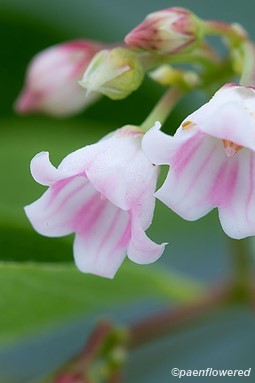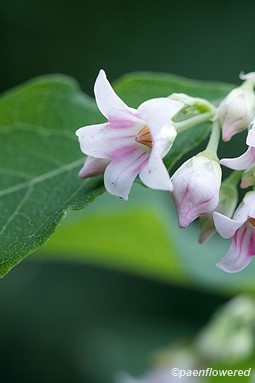Apocynum androsaemifolium
Apocynum androsaemifolium spreading dogbane
This perennial belongs to the dogbane family and derives its common name, spreading dogbane, from its broad-spreading appearance and toxic elements that affect not only dogs but also humans and other mammals. Dogbane flowers bloom from June to August, displaying small fragrant bell-shaped blossoms in pink to white with pink or red stripes on the interior and lobes that either spread or curve backward. The leaves range from green to blue-green and are oval to oblong in shape, changing to yellow in fall with lighter and pubescent undersides. They have a smooth texture, lacking teeth along the edges, with bluntly-pointed tips and a central vein that is somewhat prominent.
This plant can grow as tall as 3 feet and generally spreads through underground rhizomes, creating extensive patches. Breaking its stem or leaves exposes a milky sap that holds cardiac glycosides toxic to humans and mammals. However, in spite of the plant’s toxic nature, it remains an important food source for insects like bees, wasps, flies, including the monarch butterfly.
It is found almost everywhere in the United States and present throughout Pennslyvania in dry, open environments like woodlands and along roadsides. Not to be confused with its close relative, Apocynum cannabinum (Indian Hemp) which features ascending leaves and upright flowers that range from white to greenish, much shorter in length and with lobes that do not curve backward. Indian hemp also grows taller to nearly 5 feet, typically found in wetter, sunnier environments, and used by Native Americans as a fiber for clothing, netting, and other items as well as a variety of herbal medicines in spite of its toxicity.
Habitat & Range
Common in woods, along roadsides, pastures, thickets, and barren lands. Prefers full sun and well-drained soils. Can tolerate partial shade.
Present throughout the state.
Range: Native to North America and occurs across most of Canada and the United States, except for Hawaii, Kansas, and several southeastern states including Louisiana, Mississippi, Florida, and South Carolina.
| EMP: | FACU |
|---|---|
| NCNE: | UPL |
Phenology
Flowers June to August.
Characteristics
Inflorescence loose round clusters of 2 to 10 flowers
Flowers corolla pink to red to white, pink or red stripes in interior; nodding, bell-shaped with 5 recurved or spreading lobes; 5 stamens
Leaves simple, opposite, drooping, margins entire; oval to oblong with blunt tips; green to blue-green upper surface, pale green & usually hairy lower surface; yellow to gold in fall; ⅖ to 5″ long; ⅕ to 2″ wide
Stems erect to ascending, simple or branched; smooth, light green to reddish, terete (not angled or ridged)
Rhizomes underground; plant forms dense colonies via rhizomes
Fruit dry long slender pods (follicles); in pairs; green when young turning dull red or brown at maturity; 2 to 6″ long; seeds small, brown, silky-haired for wind dispersal
Height 2 to 3 feet
Plant Codes
S-rank: S5 (Secure)
G-rank: G5 (Secure)
Ecology
Highly poisonous to humans and mammals, however, insects such as bees, wasps, flies, and butterflies feed on its nectar. Host plant for the Chyrsochus auratus, Dogbane Leaf Beetle. Bees may use the dead, hollow stems for nesting.










Comments
Have you spotted this plant in your area? We'd love to hear about your experience! Share your comments or questions about the plant below. Comments are moderated before posting.